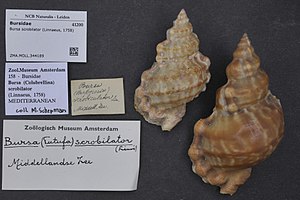Smallpox frog snail
| Smallpox frog snail | ||||||||||||
|---|---|---|---|---|---|---|---|---|---|---|---|---|

Housing of the bursa scrobilator |
||||||||||||
| Systematics | ||||||||||||
|
||||||||||||
| Scientific name | ||||||||||||
| Bursa scrobilator | ||||||||||||
| ( Linnaeus , 1758) |
The smallpox Frog Snail ( Bursa scrobilator ) is a medium-sized predatory living snail from the family of the frog snails , which in the eastern Atlantic Ocean and in the western Mediterranean is widespread.
features
The snail shell of Bursa scrobilator has a high, narrow thread on which the varices are not strictly in the spiral rows, but are slightly offset from one another. The anterior siphon channel is very long compared to other frog snails, while the posterior anal channel is only short and wide open, so that it forms little more than a notch in the flange of the outer lip of the housing mouth. The raised, closely rounded varices form concave cavities between the main ridge and the rest of the shell surface both on the side of the case mouth and opposite, so that the four raised spiral cords on both sides of each varix form strongly protruding pillars. The cords form four low, rounded knots on the outer ridge of each varix. There are many low rounded knots and usually a few large, widely spaced rounded knots on the shoulder angle cord and numerous smaller rounded knots on most or all of the three lower larger cords. Over the entire surface of the Teleoconch run frizzy, narrow, clearly separated, tightly running spiral ridges with small, closely spaced, elongated grains in the spiral direction. The protoconch consists of about 3.75 turns. The case is up to 7 cm high.
distribution and habitat
Bursa scrobilator is, besides Aspa marginata (Gmelin, 1791), the only frog snail species found in the eastern Atlantic . She is the only recent representative of the family in the Mediterranean . Today, however, it is one of the rarest snail species in the Mediterranean. It can be found in the western Mediterranean on the coasts of Spain , Italy , Morocco and Algeria , in the Atlantic on the Algarve, among others . It is more common on the Canary Islands and the Atlantic coast of Morocco and Western Sahara . The snail lives in shallow water in crevices in the rock, where it is protected from water movements. She is nocturnal.
Life cycle
Like other frog snails , Bursa scrobilator is sexually separate. The male mates with the female with his penis . Veliger larvae hatch from the eggs and live as plankton until they have metamorphosed into the finished snail.
food
In the Canary Islands, coral polyps and sea urchins in particular were observed as frequent prey of Bursa scrobilator , whereby the feeding process proceeds quickly according to observations in the aquarium.
literature
- Jose F. Verdejo Guirao: About Bursa scrobilator Linné, 1758.
- JR Houbrick, V. Fretter (1969): Some aspects of the functional anatomy and biology of Cymatium and Bursa. Proceedings of the Malacological Society of London 38, pp. 415-429.
Web links
- Fischhaus Zepkow: Family Bursidae - frog snails
- Underwater Kwajalein: Bursa scrobilator (Linnaeus, 1758)
- Bursidae: Bursa scrobilator (Linnaeus, 1758). From: JM Poutiers: Gastropods . In: Kent E. Carpenter, Volker H. Niem (Eds.): FAO Species identification guide for fishery purposes. The living marine resources of the Western Central Pacific. Volume 1: Seaweeds, corals, bivalves and gastropods. Food and Agriculture Organization of the United Nations, Rome, 1998. p. 552.
Individual evidence
- ^ A b A. G. Beu: Neogene Tonnoidean Gastropods of Tropical and South America: Contributions to the Dominican Republic and Panama Paleontology Projects and Uplift of the Central American Isthmus. Paleontological Research Institution, 2010. p. 63.
- ↑ Arianna Fulvo, Roberto Nistri: 350 du monde entier coquillages. Delachaux et Niestlé, Paris 2005.
- ↑ a b Jose F. Verdejo Guirao: About Bursa scrobilator Linné, 1758. Retrieved April 20, 2018.